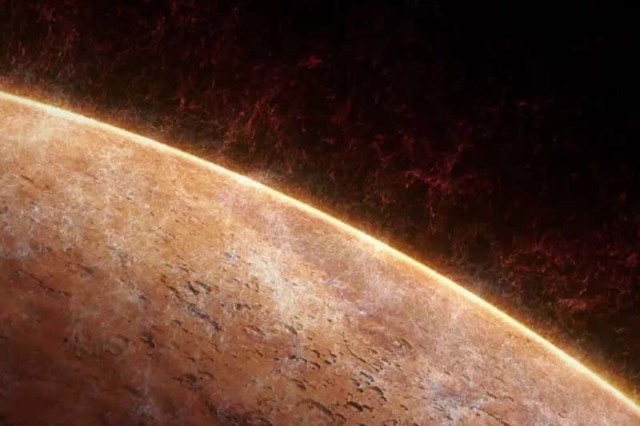Dust storms on Mars are drying the planet out by throwing water from its atmosphere into space. Bro, chill! Chill!

Mars is straight fucking itself up, man. Dust storms on Red Planet are drying it out. Sending the water from the atmosphere right into motherfucking space! You’re playing yourself, my dude.
Science Mag:
Two years ago, Mars went undercover. Martian dust storms are common, but every decade or so, for reasons unknown, a monstrous one goes global, veiling the planet. The storms can be a mortal threat to exploration: The one in 2018 killed off NASA’s Opportunity rover by coating its solar panels in dust. But now, researchers say the storms may also be one of the culprits in the ultimate martian cold case: how the once-wet planet lost its water.
Fossilized rivers and deltas etched across Mars suggest water flowed there billions of years ago. Most of it must have somehow escaped to space—yet researchers thought water vapor could not travel high in the frigid, thin atmosphere without condensing into snow and falling back to the surface. New data from NASA’s Mars Atmosphere and Volatile Evolution (MAVEN) orbiter, published today in Science, show how churning dust storms may in effect pump water into space. “These escape processes are an effective way to make Mars dry,” says Anna Fedorova, a planetary scientist at the Space Research Institute of the Russian Academy of Sciences.
One known escape process comes from the Sun’s ultraviolet (UV) light, which can split small amounts of water near the surface of Mars, sending hydrogen and oxygen—both lighter than the planet’s mostly carbon dioxide air—percolating to the top of the atmosphere, where they are lost into space. But scientists assume water loss by this mechanism is a trickle.
During the 2018 storm, however, Shane Stone, a graduate student at the University of Arizona, was looking at data from MAVEN, which has studied the planet’s upper atmosphere since 2014. One MAVEN instrument directly samples the gossamer atmosphere as the probe dips to its lowest orbital altitude of 150 kilometers, and Stone and his colleagues couldn’t believe what it was reporting: While the dust swirled at lower altitudes, a deluge of water was reaching the edge of space. “This was really a smack in the face,” Stone says. “The global dust storm stands out in the data like nothing else.”
Earlier hints that dust storms might somehow be lofting water came in 2014, when two teams reported on UV observations made in 2007, after the last global dust storm, by the Hubble Space Telescope and the Mars Express orbiter. The teams noticed a fluorescent fog of hydrogen in the upper atmosphere, which faded as the southern hemisphere’s summer ended and the storm subsided. The only plausible source for that hydrogen was water. “That was the first hint of something weird going on,” says Michael Chaffin, a planetary scientist at the University of Colorado, Boulder, who led the Mars Express work.
Since then researchers using instruments on MAVEN and the European Space Agency’s Trace Gas Orbiter (TGO) have found evidence for water high in the atmosphere during the southern hemisphere’s summer, when solar heating stirs up dust. That was true even when there wasn’t a full-fledged dust storm, says Fedorova, who led the TGO work, published in January in Science.
Fedorova and colleagues believe dust drives a positive feedback that pumps water into the upper atmosphere. Sun-warmed dust particles radiate heat into the lower atmosphere, driving winds that kick up more dust, which in turn leads to more heat and more dust. A warmer atmosphere can hold more water vapor, and the dust itself likely drags water along with it as it swirls into the upper atmosphere.
The TGO observations showed water levels gradually increase through the southern summer, but the MAVEN data suggest regional and global dust storms drive the largest spikes. Over the course of 2 days near the start of the 2018 storm, water abundance in the upper atmosphere, normally about 3 parts per million, more than doubled; by summer’s peak, the storm and the overall warming ultimately combined to push those levels to 60 parts per million. “It’s just a huge influx of water,” Stone says.
High in the atmosphere, UV light readily splits the water, allowing the hydrogen and oxygen to be lost to space. But Stone and his colleagues believe another destructive mechanism dominates. Their models suggest carbon dioxide, ionized by particles in the solar wind that bombards the atmosphere, vigorously splits the water molecules apart. “They’re making a good case,” though the importance of the mechanism needs to be better quantified, says John Clarke, a planetary astronomer at Boston University.
The MAVEN team has calculated that if the observed loss rates persisted throughout martian history, they believe Mars lost enough water that, if laid evenly atop the planet’s surface, it would form a global ocean more than 25 meters deep. But how long this dust-driven destruction has operated on Mars is anyone’s guess, Stone adds. It could be recent, or it may have been key to drying out the planet billions of years ago. Researchers believe the planet once had a protective magnetic field that failed early in its history, allowing the solar wind to penetrate deeper in the atmosphere, where global dust storms were putting water in harm’s way. That could have caused water loss to surge, Chaffin says. “Maybe you fall off a cliff and get this seasonal and dust-driven loss,” he says. What MAVEN is witnessing now, he adds, could be the end of a “planetary death spiral.”




